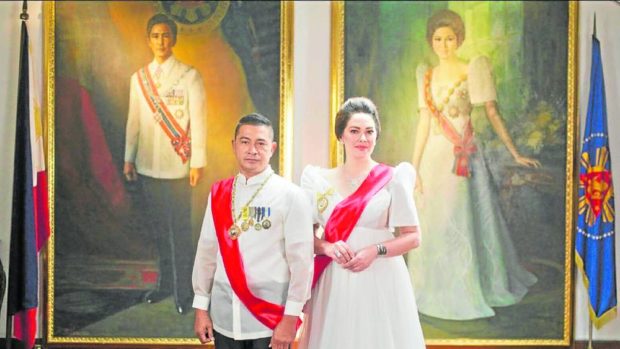
A scene in the upcoming film “Maid in Malacañang” with Cesar Montano as President Ferdinand Marcos and Ruffa Gutierrez as Imelda Marcos.
CEBU CITY, Cebu, Philippines — On the eve of its premiere, the controversial film “Maid in Malacañang’’ and its director Darryl Yap managed to offend a few more people, this time from the religious sector.
The Order of Discalced Carmelites in this city cried foul on Tuesday over a new trailer of the film showing their members playing mahjong with Corazon “Cory” Aquino when the would-be President sought refuge in their convent in the early stages of the 1986 Edsa People Power Revolution in Manila.
Sister Mary Melanie Costillas, prioress of the Carmelite Monastery in Cebu City where Aquino stayed for 14 hours for security, said: “Depicting the nuns as playing mahjong with Cory Aquino is malicious. It would suggest that while the fate of the country was in peril, we could afford to leisurely play games.”
“The truth was that we were then praying, fasting, and making other forms of sacrifices for peace in this country and for the people’s choice to prevail. While in our prayer, we were certainly in fear that the military would come to know of the whereabouts of Cory Aquino and would be knocking at the monastery’s door,” Costillas said in a statement.
Costillas said they were surprised to learn about the trailer since no one from the movie production came to see them to gather information on what really happened during Aquino’s stay.
Trivializing
“Any serious scriptwriter or movie director could have shown such elementary diligence before making such a movie. After all, many of those nuns in the Carmelites Monastery of Cebu in 1986 are still alive and mentally alert,” Costillas said.
The trailer, she said, not only trivialized whatever was the convent’s contribution to the restoration of Philippine democracy but also put in question the role played by the Carmelites over the last seven decades for Cebu’s Catholic faithful.
“With the grace of God, we take his vocation to pray for and with the people in all seriousness. But the pictures would imply that while the country’s fate was in a balance, we mindlessly were simply playing games. Thus, if these pictures would be taken as authentic representation of what really happened, they would put into doubt the trust that the people have placed in us,” she added.
Citing one inaccuracy, she said the trailer showed the Carmelites in white habits when they should be brown.
Amid efforts to distort the truth, Costillas said, they continue to pray for the unity of the Filipinos “but this unity can only be built on trust and not on historical distortion.”
Prayer for safety
Accompanied by her Cebuano friends, Aquino arrived at the Carmelite monastery around 9 p.m. on Feb. 22, 1986, said Mother Mary Aimee Ataviado, the Mother Superior at the time, in an earlier interview with the Inquirer. Being home to contemplative nuns under “Papal enclosure,” the monastery is off limits to outsiders and only heads of state are exempted from this rule.
Ataviado, now 93, said they prayed hard for the safety of Aquino when she left the monastery for Manila around 11 a.m. of Feb. 23, 1986.
Two days later, close to midnight of Feb. 25, Marcos and his family left Malacañang and were flown on a US military aircraft to Hawaii. By then Aquino had been sworn in as the duly elected President at Club Filipino in San Juan.
Ataviado then called on Filipinos not to distort the truth about the country’s history. “We need to keep the memory alive. We need to keep on telling the story just like how the Hebrews relive the story of redemption. By paying attention to history, we learn lessons,” she said.
With the support of Sen. Imee Marcos, daughter of the deposed dictator Ferdinand Marcos and sister of the President, “Maid in Malacañang” is being marketed as a retelling of the Marcos family’s last three days in power before fleeing Malacañang.
Amid criticism from victims of martial law atrocities during the Marcos regime, Yap, 35, said during a promotional event last month that he was “very happy at the attention” being generated by his film.
—WITH A REPORT FROM ADOR VINCENT MAYOL
RELATED STORIES
Martial law survivors ready vs ‘Maid in Malacañang’ whitewash
Ang-See: I can’t just watch historical distortion
Carmelites nuns on ‘Maid in Malacañang’: Attempt to distort history is reprehensible
‘Maid’ to enrage: Critics ready; Imee defends ‘our point of view’